Introduction
In July 2024, I received an email from Liz who wanted to know about St. George's House at 101 St. George's Road, St. Augustine's, In 1903, a relation, John Edward Whittington Jones, was listed as living there and Liz wanted to know something of the history of the building.
Here is everything I know about the building and general area. If you know more, please email me.
Today
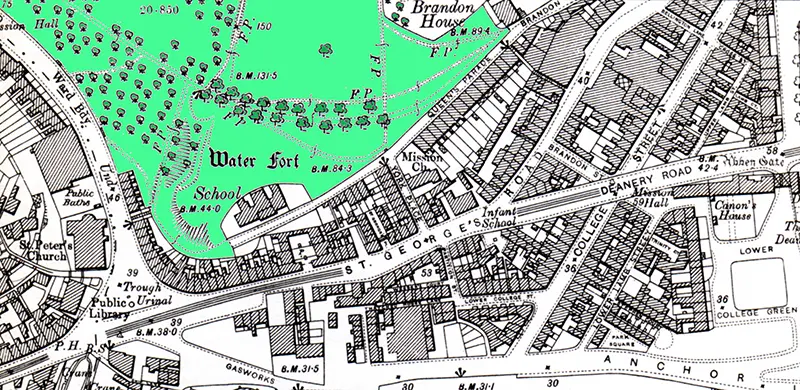
St. George's House is the large n-shaped building below the Water Fort and school on Brandon Hill
Image: 1902 Ordnance Survey map, Bristol (SW), Gloucestershire Sheet 75.04, reprint by Alan Godfrey Maps
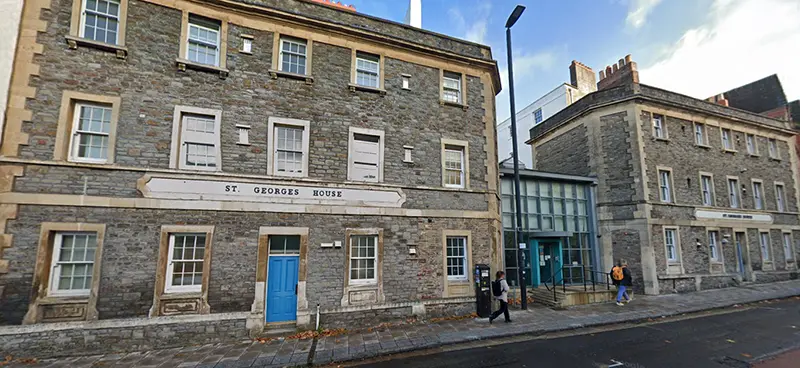
St. George's House, St. George’s Road, St. Augustine’s
Image from Google Maps
St. George's House is now a young people's support centre, 1625 Independent People, offering short-term emergency accommodation for 16 to 21-year olds.
Development of the Area
The city council website has a marvellous set of maps and information for almost every part of the city. Much of the following information comes from those.
There were two potteries on the lower southern slopes of Brandon Hill producing tin-glazed earthenware. The "Lower Pottery", which was on Cow Lane, now the site of St. George's House, was owned by a Mr. Hobbs and operated between circa 1706 and circa 1746. Between 1724 and 1734, John Weaver and William Pottery ran the business. It then continued under Charles Christopher (1734-1737), Josiah Bundy (1739-1741), possibly Thomas Pennington (1741-1742) and finally James Gaynard until it closed probably before 1746. William Pottery also owned the upper pottery and ran it as a separate business between circa 1734 and circa 1740. The site of this pottery has not yet been determined.
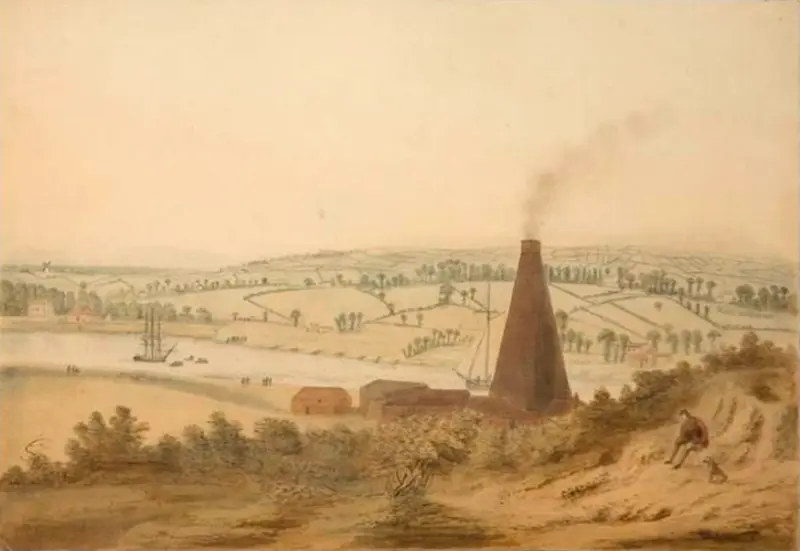
Limekiln Lane Glass House Cone
Unknown artist but probably 1790
The 1750 Rocque map shows the area to be slightly developed with some housing and agriculture. St. George's Church of England primary school, closed in 2021, at the foot of Brandon Hill has not been built. The general route of St. George's Road can be seen, but at the time was known as Cow Lane. It would later be renamed Limekiln Lane before finally being named St. George's Road. To the south can be seen a Rope Walk. As a seaport, Bristol had several of these.
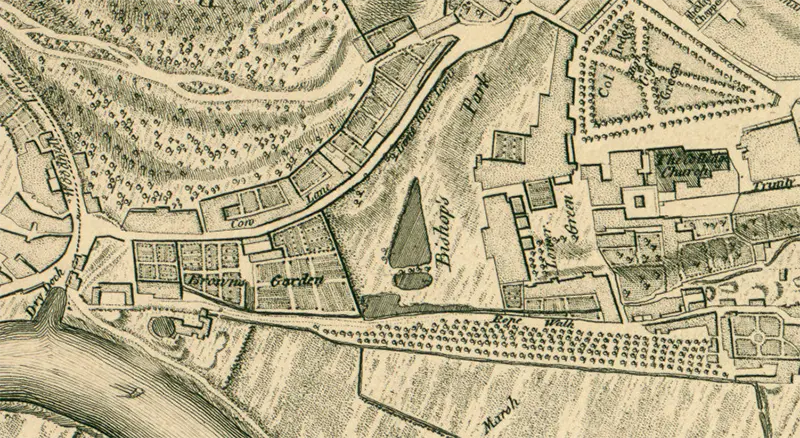
The area around St. George's Road, St. Augustine’s from the 1750 Rocque map
The 1828 Ashmead map shows several changes. Queen's Parade had been built and Cow Lane is now Limekiln Lane. Of course therre are always anomalies. Cow Lane turns up again in the 1871 census, with Henry (38, quarryman, born 1833), his wife Charlotte (50, born 1821) Dight and daughter Elizabeth M, (6, born 1865) listed as living in Cow Lane.

The area around St. George's Road, St. Augustine’s from the 1828 Ashmead map
The 1855 Ashmead map shows an interesting development. The school on he southern edge of Brandon Hill has been built. More building has done along Limekiln Lane but opposite the school is a large empty space where St. George's House would later be.
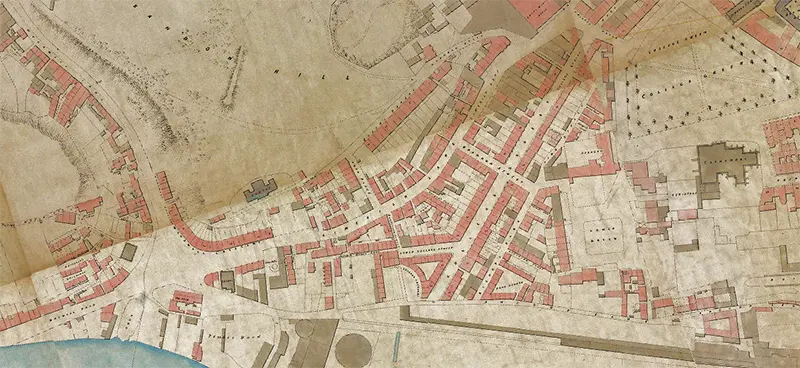
The area around St. George's Road, St. Augustine’s from the 1855 Ashmead map
This advert appeared in the Bristol Mercury of Saturday, June 28, 1856. I have to admit to being slightly disappointed. Rather than some grand old building, St. George's House was built as model dwellings.

An advert for builders for St. George's House
Bristol Mercury of Saturday, June 28, 1856
The advert reads:
To BUILDERS.
MODEL LODGING-HOUSE CONTRACT.
The time for sending in TENDERS for the new BUILDINGS in LIMEKILN LANE is extended to 8th July next. The Plans and Specifications may be seen at the offices of the Architects, Mssrs. FOSTERS & WOOD, 4 Park-street.
CHAS. JACKSON, Sec.
2, Exchange buildings, Bristol, June 26, 1956
It is difficult to see on the 1874 Ashmead map, but what was to become St. George's House had been built, except it was originally called Victoria Buildings. The 1881 census still lists the building as Victoria Buildings. The building is not named on later maps until the 2019 one which shows it as St. George's House. The building is an Unlisted Building of Merit in the Park Street and Brandon Hill Conservation Area.
The renaming of Limekiln Lane had begun with various sections of it, from west to east being named Hotwell Road, St. George's Road and the eastern-most part still named Limekiln Lane. The 1880 and later maps show the whole stretch of road being named St. George's Road. The 1880 and 1890 maps both show there was a tramway running along it.
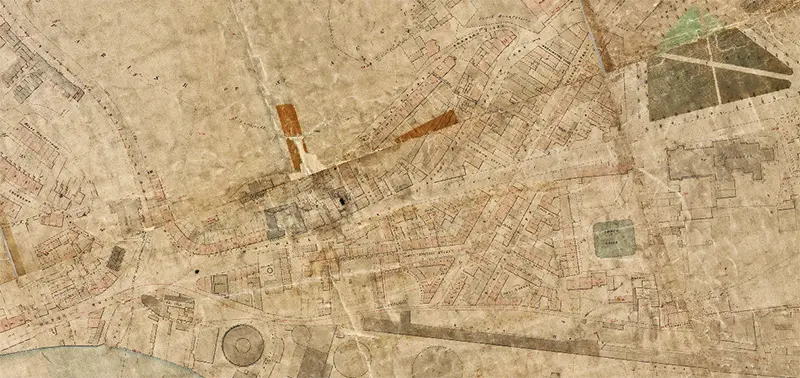
The area around St. George's Road, St. Augustine’s from the 1874 Ashmead map
The Residents
The 1881 census show that the following people lived in Victoria Buildings:
#1 - William (34, a farrier) and his wife Kate (30, laundry ironer) Silcocks lived with their children William (9), Thomas (8), and Walter (2).
#2 - John (45, a shipwright from Bideford, Devon) and his wife Harriett (58, a laundress) Chapman lived their daughter Eveline (19, tailoress), grandson James Fluke (7), and lodger Charles Bond (24, butcher journeyman).
#3 - John (42, shipwright) and his wife Fanny (38, charwoman) Dunn lived with their children Teresa (9), Fanny (7), Ada (5), Mabel (3), and John (3 months). John Henry Dunn & Fanny Susanna Ley were married in Bristol in September 1862.
#4 - Charles (52, a blcksmith from Alveston, Gloucester) Gay lived with his children Lily (18, domestic servant), Florence (14), and Alice Maud (12), along with granddaughter Rose Gay (10 months).
#6 - George (52, a ship carpernter from Coalpit Heath, Gloucester) and his wife Eliza (51 Abergavenny, Wales) Britton lived with their children George H. (22, marble mason), Charles A. (23, shoemaker, born in Chatham, Kent), Ada Jane (16, domestic servant), Eliza Jane (10), Florence (9), and Rosina (6). Also living with them was Alice Howe aged 2. George Britton & Eliza Lloyd were married in Bristol in September 1851.
#7 - Robert (36, a baker from Bradninch, Devon) and his wife Annie (34, from Stroud, Gloucester) Holmes lived with their children Henry G. (17, a baker, born in North Petherton, Somerset), Robert R. (11), Alice A. (9), Herbert G. (7) son Sidney C. (4) Bristol Scholar Edgar J. (3 months). Robert Holmes & Ann Ratcliffe were married in Bridgwater, Somerset in December 1863.
#8 - James (69, a labourer from Harland, Devon) and his wife Mary Ann (56) Prouse lived with their children Mary Jane (25, bridle stitcher), James H. V. (19, saddle tree maker), and Georgina (16, teacher). James Prouse & Mary Ann Morgan were married in Bristol in September 1854.
#10 - George (41, shipwright) and his wife Ann (40, from Westbury, Gloucester) Hanson lived with their children William G. (16, labourer), Elizabeth (15, domestic servant), Charlotte (13), Ernest (10), Sarah (2), and Frederick (2 months). George Gayton Hanson & Ann Marin Macey were married in Clifton in June 1862.
#13 - Robert (54, was a parlysed halulier Hutton, Somerset) and his wife (49, a laundress from Banwell, Somerset) Rice lived with their children Amelia A. (23, an envelope maker), Mary Jane (16, a laundry ironer), Walter (14, errand boy), and Robert (11). Robert Rice & Elizabeth cox were married in Bedminster in June 1855.
#14 - William Hebblewhite (31, a stableman from Cardiff, Glamorgan, Wales) and his wife Annie E. (32, from Blunston, Wiltshire) Robson lived with their children William A. (8, born in Westbury, Gloucester), Lorymer H. (6), Emily A. (5), and George F. (3). Also living with them was George Young (14, an errand boy from Clevedon, Somerset). William Hebblewhite Robson & Annie Elizabeth Weston were married in Keynsham in March 1872.
#15 - Louisa Alvis (52, a charwoaman from Petherton, Somerset) lived with her children Alfred (17, warehouse clerk), and Amelia (12).
#16 - Henry Robert (35, tailor) and wife Matilda (38, waistcoat maker) Brooks lived with their children Matilda (14), Ellen (11), son Francis H. (10), and Albert E. (4). Henry Robert Brooks & Matilda Dicker were married in Clifton in December 1865.
#17 - James (63, a labourer from Preston, Somerset) and wife Elizabeth Ward (62, a laundress from Stanton Prior, Somerset) lived with their son James (25, a labourer).
#18 - James (55, a woollen draper from Alwington, Devon) and his wife Sarah Ann (57). James Jeffery & Sarah Ann Eastmead were married in March 1850.
#19 - Mary Ann Hayden (48, a charwoman from Swimbridge, Devon) and her children Charles W. (14, errand boy), Albert E. (13, errand boy), and Arthur R. (9). Also living there were her granddaughter Lily E. (1), and lodger George Dudridge (20, labourer). Mary Ann Louisa Ensor was married to Charles Hayden in Bedminster in September 1855, but he is not listed as living in Victoria Buildings.
#20 - Joseph Sanuel (50, a ship carpenter) and wife Caroline (51, from Exeter) Ford and children Henry C. (17, clerk), Christiana (15, domestic servant), and Silas (10). Joseph and Caroline Ware were married in December 1851. There seems to be two families living at #20, the other appears to be Caroline's son and family. Joseph (27, cork cutter) and wife Elizabeth (25) Way and their children, Joseph (4), Herbert (3), Frederick C. (1). Joseph and Elizabeth Kate Ford were married in June 1876.
#21 - Henry (53, a coach maker from Newbury, Berkshire) and his wife Sarah (53, a laundry ironer from Bristol) with children William (23, a labourer / painter), Henry (20, a butcher journeyman born in Cork, Ireland), Sarah (18, a domestic servant born in Cork, Ireland), and Emily (13 born in Ripon, York).
#22 - Samuel (42, labourer) and wife Mary Ann (41, tailoress) Wilcox and children Samuel J. (16, labourer), Edward C. (13), and Anna (10). Also living there was John Matthews (51, carpenter).
#26 - Henry (43, a clerk from Calcutta, India) and his wife Susannah (44, a confectioner from Stanton Drew, Somerset) Jones
#27 - Alfred (47, a tailor from Preston, Somerset) and wife Elizabeth (46, a tailoress from Yeovil, Somerset) Lewis with their children, Lyndell James (26, a labourer born in Yeovil, Somerset), Ellen (21, a sempstress), Albert (15, a porter born in Yeovil, Somerset), William (13, born in Yeovil, Somerset), Sophia (11 born in Yeovil, Somerset), Christiana (6, born in Bristol), Rebecca (3 , born in Bristol). Also living with them was Edmund (9) who appears to be Lyndell James' son.
#28 - Thomas Newbury (40, a Cab Proprietor) with children Amelia Jane (20, a domestic housekeeper), William (18, a cab driver), George (17, a cab driver), Charles (15, a stableman), Emma (12), Eliza (10), and Caroline (9).
#29 - Samuel (42, a labourer from Bridgwater, Somerset) & Matilda (40, from Wells, Somerset) with their children William (19, born in Wells, Somerset and now a brushmaker), Elizabeth (12), Henry (10), and Samuel (1).
#30 - William (47, a taylor from Waterford County, Ireland) & Mary (41, from Somerset) Leahy with their children Angelina M. (16), son Francis (12), Patrick E. (10), Thomas C. (7), Catherine (3), Cornelius (1), and John F. (1).
The 1891 census show that the following people lived in Victoria Buildings:
#2 - Alfred G. (44, shoeing smith) and his wife Maria (34, born in Serney [possibly Cerney, Wiltshire]) Kingston lived with their children Grace C. (9) and James W. (4). Also living with them was Sarah A. Stephens (11).
The following needs checking as confusingly there was a Victoria Buildings in St. George, and another on Pennywell Road.
Approximately 1,582 men from Bristol were killed in the last year of WWI (1914 -1918) and the youngest of these was just 16-years-old. William Joseph Clements, a deck boy and the son of Frederick and Elizabeth, who lived at 9 Victoria Buildings was aboard the hospital ship HMHS Llandovery Castle when it was torpedoed off the coast of Ireland on June 27, 1918. William’s body was never recovered.
Sources & Resources
1625 Independent People
1871 Census (Dight Family History)
Bristol City Council map site
Bristol Delftware Factories
Investigation of 18th Century Glass and Glassworking Waste From Limekiln Lane, Bristol (Center for Archealogoy)
Limekiln Lane Glass Works (Heritage Gateway)
Limekiln Lane Pottery (Bristol Potters and Potteries)
Limekiln Lane Pottery (British Museum)
Limekilns in Avon (Bristol Industrial Archaeological Society)
Park Strret &; Brandon Hill Character Appraisal (Bristol City Council) - Some interesting information about the area
Ropewalk (Wikipedia)
The shocking number of young Bristol men who died in the final year of World War I (Bristol Post)
Winter Family Bristol (RootsChat)